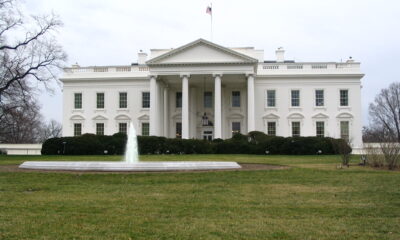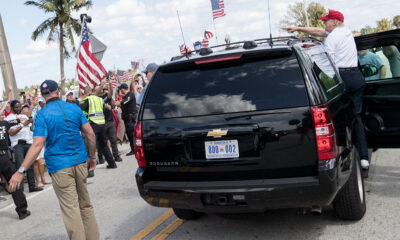Executive
Secret Service Scuffle Prompts DEI, Vetting Scrutiny

An incident involving a physical attack by a female Secret Service agent tasked with protecting Vice President Kamala Harris is raising questions about whether the agency had thoroughly vetted her during her hiring and whether an ongoing push to increase the numbers of women in the service and boost overall workforce staff played a role in her selection.
The rogue Secret Service agent’s story gets wilder by the day
The Secret Service agent assigned to Vice President Kamala Harris was removed from her duties Wednesday after physically attacking the commanding agent in charge and other agents trying to subdue her, according to an agency spokesman and knowledgeable Secret Service sources.
Several sources in the Secret Service community identified the agent who physically attacked her superior as Michelle Herczeg. The altercation occurred at approximately 9 a.m. at Joint Base Andrews, the home base for Air Force One and Air Force Two, the call signs of the Boeing aircraft used by the president and vice president. Harris was at the U.S. Naval Observatory at the time of the incident, and it did not delay her travel, said agency spokesman Anthony Guglielmi.
Herczeg showed up at the terminal and began acting erratically, grabbing another senior agent’s personal phone and deleting applications on it, according to two sources familiar with the matter. The other agent, a shift leader, was able to recover his phone and then acted as if nothing had happened.
But Herczeg’s bizarre behavior didn’t stop. She then began mumbling to herself, hid behind curtains, and started throwing items, including menstrual pads, at an agent, telling him that he would need them later to save another agent and telling her peers that they were “going to burn in hell and needed to listen to God,” a source told RealClearPolitics.
A mental lapse?
Herczeg also screamed at the special agent in charge (SAIC), rattling off the names of female officers on the vice president’s detail and claiming they would show up and help her and allow her to continue working. At that point, other agents on the scene believed Herczeg was suffering from a mental lapse, and the superior officer, SAIC, approached her to tell her she was relieved from the assignment.
“That’s when she snapped entirely,” one source recounted.
Herczeg then chest-bumped and shoved her superior, then tackled him and punched him. The agents involved in restraining Herczeg were especially concerned because she still had her gun in the holster. They wrestled her to the ground, took the gun from her, cuffed her, and then removed her from the terminal.
The agent was immediately “removed from their assignment,” a Secret Service spokesman told RCP in a statement. The Washington Examiner first reported the incident.
Bland reportage and legal disclaimers
“A U.S. Secret Service special agent supporting the Vice President’s departure from Joint Base Andrews began displaying behavior their colleagues found distressing,” said Guglielmi, chief of communications for U.S. Secret Service.
The agents on the scene then called medical personnel to remove Herczeg from the terminal. Guglielmi has described the incident as a “medical matter” and said the agency would not “disclose further details.”
“The U.S. Secret Service takes the safety and health of our employees very seriously,” he added. But the bizarre scuffle is once against raising concerns about the state of the once-vaunted force charged with protecting the president.
Following the incident, Secret Service agents and officers are privately questioning the hiring process and whether the agency had adequately screened Herczeg’s background. Some also wonder whether her hire was part of a diversity, equity, and inclusion push in response to years of staff shortages that may have required the agency to lower its once-strict employment standards and physical performance to reach quotas for female agents and officers.
A history of lawfare – and why did the the Secret Service miss that?
In 2016, Herczeg, then an officer with the Dallas police force, filed a gender discrimination lawsuit against the city, claiming she was assaulted by a male superior and asking for more than $1 million in damages.
The suit alleged that Herczeg was “targeted for being a female officer and treated less favorably” and was retaliated against after she reported sexual harassment and illegal actions of other officers. She also claimed she was not allowed to return to a crime-reduction team after she alleged a senior officer assaulted her. A Texas trial court dismissed the suit, Herczeg appealed, and a Texas court of appeals affirmed the lower court’s decision in 2021 and denied a rehearing in 2022.
While serving on the Dallas police force, Herczeg and another officer shot an armed man while he sat in a parked car. . According to a department spokesman, the officers were firing in self defense because the man, who had previously been convicted of sexually assaulting a child, was brandishing a weapon and eventually shot himself in the head. A headline in the Dallas Observer raised some doubt about the official police account: “Two Dallas Cops Shot a Man Last Night, but They Say He Killed Himself.”
Ronald Kessler, a former investigative reporter for the Washington Post who has written several books on the Secret Service said the agency would have traditionally viewed the dismissed discrimination lawsuit as disqualifying.
A DEI hire
“Yes, that should have been enough to exclude her, because you really have to have a pristine record,” he told RCP Wednesday. “Certainly, this has been true in the past. There’s tremendous competition, and she never should have been hired.”
Kessler also pointed to a new initiative to increase the number of women in the Secret Service workforce. Guglielmi confirmed that the agency is one of numerous federal, state, and local law enforcement agencies that have signed onto the 30×30 initiative, an effort to increase the representation of women in all ranks of policing across the country to 30% of the workforce by 2030.
“Claims that the Secret Service’s standards have been lowered as a result of our signing this pledge are categorically false,” Guglielmi told RCP. According to the initiative’s website, women currently make up only 12% of sworn officers and 3% of police leadership in the U.S., a low statistic that 30×30 advocates says “undermines public safety.”
“Research shows that women officers use less force and less excessive force; are named in fewer complaints and lawsuits; are perceived by communities as being more honest and compassionate, see better outcomes for crime victims, especially in sexual assault cases, and make fewer arrests,” the website states.
Scandal plagues the entire agency
“It is critical that participating agencies focus on increasing the representation of all women,” the website adds. “They must account for the diverse experiences of all women of all backgrounds and life experiences to better promote the creation of a diverse and inclusive workplace for everyone.”
The Secret Service has an “Inclusion and Engagement Council,” which pledges to become the agency’s “game-changers” when it comes to helping the agency “build, foster, create and inspire a workforce where diversity and inclusion are not just ‘talked about’ but demonstrated by all employees through ‘Every Action, Every Day.’”
During President Obama’s time in office, the Secret Service experienced a string of scandals and several changes in leadership, including the appointment of its first female director, Julia Pierson. Obama appointed Pierson in March 2013 in an attempt to change the culture of the agency, which was then under scrutiny after a Colombian prostitution scandal. But Pierson lasted less than two years on the job when she resigned in the face of multiple revelations about drunken behavior and security breaches, including one in which Obama had shared an elevator in Atlanta with an armed guard who was not authorized to be around him.
Obama should have installed an outsider to head the Secret Service
In 2014, a blue-ribbon panel convened at the height of several scandals, and several members of Congress urged Obama to tap an “outsider” to head the agency, a recommendation he ignored. There were complaints that only a new director unconnected to the current and former leadership could truly change the insular culture and uneven discipline partially responsible for low morale and a mass exodus of agents and uniformed division officers fleeing the agency.
In August 2022, President Biden appointed Kimberly Cheatle, a 27-year veteran of the agency, as the director and only the second woman to lead it. She replaced James Murray, a Trump appointee, who announced his retirement after three years on the job. During the Trump administration, the agency faced its own set of controversies, including missing text messages to and from agents around the time of the Jan. 6, 2021, attack on the Capitol.
In recent years, the Secret Service has ranked either dead last or near the bottom of a government employee survey of job satisfaction conducted annually by the nonpartisan Partnership for Public Service. The agency’s most recent ranking for 2023 is near the bottom at No. 375 out of 432 agencies.
Those morale problems, tied to agents’ and officers’ crushing workloads – long hours amid increased security demands from the White House and in protecting presidential candidates in recent years – have led to lagging employment and poor retention rates.
Lowering the standards
Gary Byrne, a former Uniformed Division officer who wrote a book about his experiences protecting President Clinton, said there have been plenty of exceptions to usual Secret Service standards in the agency’s hiring practices, including numerous incidents of nepotism.
Byrne remembered a push for more female agents during the Clinton administration and one female Secret Service officer telling him that she was never required to take a polygraph before she was hired, which is a requirement for all officers and agent applicants.
“They tell you if you have character issues or mental-stability issues, you can’t take the job, they’ll find out about it,” he said, though many times mental health issues have remained hidden until they surface under stress.
“If you have any instability issues at all, this job will expose them,” he said.
This article was originally published by RealClearPolitics and made available via RealClearWire.
Susan Crabtree is a political correspondent for RealClearPolitics. Shepreviously served as a senior writer for theWashingtonFree Beacon, and spent five years asa White House Correspondent for theWashington Examiner.
-
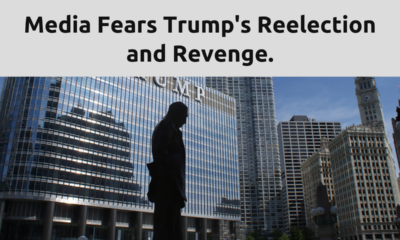
 Civilization4 days ago
Civilization4 days agoLegacy media already assume Trump wins
-
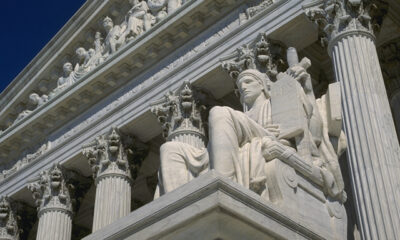
 Civilization5 days ago
Civilization5 days agoSCOTUS Is Last Bulwark Against Critical Legal Studies
-
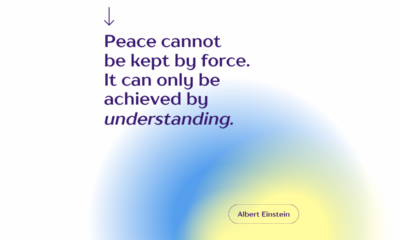
 Civilization2 days ago
Civilization2 days agoAntisemitism – and misguided legislation
-

 Education22 hours ago
Education22 hours agoCHAPTER 13: Fomenting Race Wars Begins in Kindergarten
Space Is No Longer the Final Frontier—Reality Is [forthcoming release May 2024] -

 Civilization5 days ago
Civilization5 days agoEnergy Pipeline Companies Should Follow the Rules of the Road
-

 Civilization5 days ago
Civilization5 days agoWhat 10 Years of U.S. Meddling in Ukraine Have Wrought (Spoiler Alert: Not Democracy)
-

 Civilization5 days ago
Civilization5 days agoThe World Health Organization’s Pandemic Treaty Ignores Covid Policy Mistakes
-
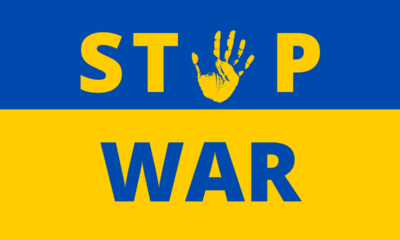
 Civilization3 days ago
Civilization3 days agoUkraine as proxy for war with Russia





